by Nicholas C. Weidhaas
"Production Tips" courtesy of Woodworking International
Tip 24
Develop a strategy for cost reduction.
Cost control and efficiency do not happen by themselves, even for the manufacturer with the best intentions. It requires first an understanding of efficiency and of how costs are distributed within the plant, and then the development of a prioritized plan for controlling and indeed, cutting costs. Finally, of course, action must follow. So often, particularly in the smaller company, costs control is neglected because of the many, many pressures that fall upon the company managers. Survival, growth, pressing schedules, and the general building of the company, capture many energies.
And frankly, it is not always necessary to be the lowest cost producer in order to be successful. There are some "niches" in the business where the competitive advantages might be design skills, or marketing skills, or ability to react quickly to the demands of the marketplace; however, for most companies the ability to produce at competitive costs is very important. Let’s now discuss the typical items of manufacturing cost which are common to many operations, and focus on some ways these costs might be reduced.
If we look at the typical sales dollar which represents the output of a furniture or cabinet plant, we find that the sales dollar can be broken down into various categories (see Figure 1). Unfortunately, most of these categories are categories of cost. Typically, only a very small part of the sales dollar ends up in the profit category. Naturally, these percentages will vary from company to company. The company which buys its parts in a state of completion which is close to the finished product, might have a higher percentage of its sales dollar falling into the materials category, and a lesser percentage falling into the labor category. The smaller custom shop would probably have a larger percentage of its sales dollar falling into the labor category. The point is that there is a distribution of costs, and hopefully profits.
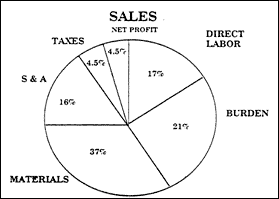
It is worthwhile to ponder the fact that profits usually represent a fairly small percentage of the sales dollar compared with some of the other component costs. This presents both a problem and an opportunity:
The problem is that if the costs grow even a small percentage, then our profits can disappear quickly; the opportunity is that relatively small percentage changes in our costs can represent major percentage changes in our profits. In our example, for instance, where material costs represent 37% of the sales dollar, if we were to save only 10% of our materials, this saving could translate to an increase in our before tax profits of about 40%. To paraphrase a line from a song – "Little things mean a lot". Seemingly small savings can have a tremendous impact on profits.
Let’s then look at some overall ways that we can reduce costs. In our approach to cost reduction in this series of articles we are first going to take a "stand-back-and-look" approach. By this, I mean we are going to focus on some broad categories of cost elements and ask ourselves what we can do to reduce them. First let’s ask, what sweeping or broad-brush approaches might be possible in each of the manufacturing cost categories? In looking at alternative cost saving potential areas, each company will find different opportunities. Each should prioritize their opportunities, and consider them from three standpoints:
- The relative ease of achieving the savings.
- The sum represented by the savings or its significance.
In this article, we will not discuss the sales and administrative cost category (S & A). First we will discuss the "materials" cost category.
In this category, typically we find included such items as lumber, particleboard, plywood, finishing and packing materials, and hardware. Often one item stands out in its contribution to total costs.
In the hardwood furniture parts business (dimension stock) for instance, lumber typically represents 40-50% of the sales price. Again there exists the problem and the opportunity. This is a major cost item! However, the nice thing about this particular cost item is that it is concentrated and accessible.
By this I mean that typically the control of the cost of the lumber, and the cost of the parts produced from it rests largely in the hands of just a few people: the lumber buyer, the employees responsible for stacking and drying the lumber, and the relatively few people who cut-up the lumber. This is in contrast to labor costs for instance, which are represented by machine operators who are spread from one end of the plant to the other. It is sometimes difficult to make a real impact on labor costs because they are so spread out, but lumber costs are relatively concentrated, and accessible. If you can get the few good people who are associated with the lumber buying, drying, and cutting, to do "their best", great savings can often be quickly achieved.
Let’s explore for a moment the idea of people doing "their best". Most people associated with stacking, cutting-off, and ripping the lumber know what should be done to save the lumber and maximize yield, but for one reason or another, often they do not do even what they know is best. Part of the problem might be that they really do not know how important their efforts are. It is the management’s job to let them know how important their efforts are so that they are motivated to do that which they know how to do. The importance of know and do cannot be overemphasized.
For many companies, part of the trick of continued cost reduction is being able to maintain focus on the area which was chosen for priority effort in cost reduction. Too often we start an effort, enjoy good savings, then go on to the next project only to have the program and savings which we had achieved drift away. A few ways that some companies have tried to maintain savings and focus on priority problems are:
- Through implementation of direct wage incentive plans where the pay of employees is influenced by lumber yield and other materials processing costs. Many companies pay employees according to their productivity levels such as with piecework systems. A few companies also incorporate a bonus system for increased lumber yield.
- Through development of more worker participation in the cost saving/quality improvement effort by implementing such programs as "quality circles", profit sharing plans, or "gain sharing" plans where employees receive part of the savings achieved in their paycheck.
- By having a "methods inspection program" which involves the foremen filling out an "airplane type" check list each day which reminds him to regularly focus on specific problem areas, and not only focus on putting out the new "everyday" problems (Previously described in WOODWORKING INTERNATIONAL, 1990). Once each day this checklist is turned in to the plant manager. Once each week, the plant manager accompanies the department foreman on the daily inspection tour. Once each month the vice-president of manufacturing takes the tour with the plant manager and the foreman. In this way, focus on the priority problems is maintained and communication through the management levels is enhanced.
- Through implementation of other creative management such as having contests where the person with the best "lumber saving idea" of the month is given a gift certificate at a local store.
- By periodically bringing in an "outsider" such as a management consultant or someone from the corporate office who will bring renewed interest and perhaps insight to the "priority" problem area.
The main point is that companies should look at their costs of materials, because these costs are often very concentrated. If judged to be a priority area, a "material-specific" costs reduction program should be implemented and maintained.
Tip 24 (Continued)
In the previous issue of WOODWORKING INTERNATIONAL we discussed the matter of cost reduction by looking at the material costs. Next, let’s discuss the direct labor category of costs.
For many companies this category of costs represents good potential. As mentioned previously, however, labor costs can be difficult to get at since they are spread from one end of the plant to the other. Again thinking in the "broad brush" manner, some sweeping things which impact labor costs from one end of the plant to the other are:
- Wage rate – In the long run competitive wages must be paid. From a practical standpoint it is usually not wise to try to reduce wage rates as a means of achieving cost savings. There are some potentials for effective wage rate reductions by not having skilled people (high wage requiring) do relatively less skill-requiring jobs (low wage required). An example of this might be found in an upholstered furniture shop where as much as possible of the lower skill requiring jobs are not performed by the highly paid upholsterer. For instance, some companies have lesser paid employees pre-cut cotton, and other filling materials before they arrive at the upholstering stations.
- Worker productivity – Another way to reduce labor costs is to increase individual worker productivity. Even if wages are higher, cost per unit of output can be lower if productivity is increased.
In comparison with the so-called "100% level of efficiency", how efficient is the typical woodworking plant? Usually not as efficient as the owner wishes it would be. Most plants which operate without engineered standards (daywork plants) are probably only 65-75 percent efficient (see table). Plants which have engineered standards and which use these standards to motivate their employees (measured daywork plants) often can operate in the 86% efficiency range. Companies which choose to have wage incentive plans where the employees pay is influenced by their productivity often operate in the 123% range.
(Productivity ranges were developed from data from the American Institute of Industrial Engineers and the author’s experience.
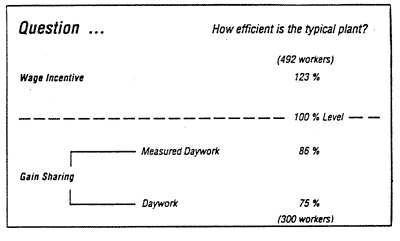
Think about this for a moment! This means that the plant with a wage incentive plan could produce more than one and one half times more than the one operating on a daywork basis with the same number of production employees. Looking at it another way, the plant with 300 production employees, operating on an incentive basis, could produce about the same amount as a plant with 492 employees operating on a daywork basis. (Based on efficiency levels of 75 percent for daywork, and 123 percent for incentive).
If this is the case, should not every plant operate on an incentive basis?
There are some negatives:
- Incentive plans can be costly to install and maintain.
- Incentive plans can lead to worker discontent, since workers attention tends to focus more on their paychecks. This often leads to the development of an adversarial relationship between management and employees.
Incentive plans are not for everyone, but they should be considered. Also there are some other alternatives.
Measured daywork plans involve the development and use of engineered production standards to motivate the employees, but their pay is not directly affected. The motivation to produce more than with the daywork system occurs because the workers are appraised to their performance and encouraged to produce. The nice thing about the measured daywork approach is that there is not the same focus on the paycheck as with the incentive programs and not the tendency to develop the adversarial relationship previously mentioned. Also, companies can benefit from developing the engineered standards in other ways as well. These standards can be used in costing the product, and the exercise alone of developing the standards usually leads to many methods improvements.
One other type of program which deserves mention is the "gain sharing" program. These programs can actually be employed in conjunction with the measured daywork programs. Essentially they involve first the assessment of an existing "cost level" of manufacturing. Then as the cost saving program progresses, savings are shared with the employees on an agreed upon formula basis. These programs are relatively easy and inexpensive to install, and are starting to enjoy good success in the wood industry.
The plans mentioned thus far can have a sweeping or plant wide effect on labor costs for a company. Two other areas which can have very broad effect are materials handling, and the balance of production capacity between departments and even individual workers when they are working in production teams. (These were previously described in WOODWORKING INTERNATIONAL April 1989 and February 1990 but are somewhat repeated here for the sake of completeness).
Value is added to the product only when it is being worked on. In a sense, the time involved in bringing the product to the machine – the handlings – is production time lost. It is not unusual to find production situations where 40-50 percent of an operator’s time is spent in handling the part from the rough parts truck to the machine, and then later, from the machine to the finished parts truck. Add to this time lost because of general trucking, and the non-productive time which is lost because of handling becomes very, very significant.
There are some ways to reduce the amount of time which is lost due to handling. Two of these are:
- Position small tables next to the machine. When possible, the operator should handle stock from the rough parts truck in handfuls to the table, then as singles to the machine. Finished parts are not returned to the table until a handful quantity is accumulated. The handful quantity is then carried to the finished parts truck. The concept of "handling in handfuls" rather than one piece at a time, is an extremely important one.
- Try to do as much of the handling as possible as the machine is running, to avoid unproductive machine time.
Imbalances between the operating rates of team members working on a project, and/or machine rates and their operator’s productivity level cause many production inefficiencies. How often have you seen two workers, working together on a project, where one of the workers is idle, waiting for the other worker to finish "his part" of the job – or, a machine standing idle waiting for the operator to load a new part?
The first step in reducing the effect of imbalances is to be aware of them – then take corrective action. Perhaps some team operations should be broken up, with each operator working independently; or perhaps some of the elements of the job could be redistributed between the operators. How can the operator do more of his handling while the machine is running and preposition the part better for quick insertion into the machine, when it is ready for a new part?
Relative to balance, one additional concept is worth pondering. The total output level of a facility is often controlled by one operation – the slowest operation. In your plant, there is a limiting operation. This operation is the "neck of the bottle".
If you can improve the productive capacity of that one operation, you can often elevate the total output level of the entire operation, perhaps with a capital expenditure associated with only improving the output capacity of the limiting operation. When you remove the No. 1 "limiting operation" it will be replaced by a new "limiting operation". When you eliminate that one, a new "limiting operation" will emerge, etc. By focusing on these bottlenecks in a stepwise fashion, overall productivity can be improved on a strategic, minimum cost basis.
The reduction of overhead costs ties in with the last paragraph. As productivity is increased the overhead cost per unit of output can be greatly improved. Naturally we should be concerned with the absolute cost of such items as head, light, power, management costs, etc. It is important to understand, however, their relevance to productivity levels, and the total output of the plant.
Tip 25
Pop-up fences on straight line ripsaws can improve lumber yield.
Have you ever stood behind a straight line ripsaw and watched board after board being edged without the production of edging strips?
A simple device can help this to happen. This device is available commercially or can be made in your own shop. A homemade version is shown in Fig. 1. Commercial versions of similar devices are operated with a foot pedal rather than by the spring shown in the homemade variety.
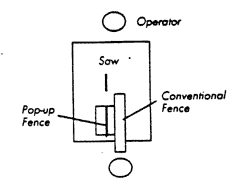
Figure 1 – Pop-up fence on a straight line ripsaw
To make one in your own shop, simply remove the small table plate which is on the operations side of the ripsaw. Cut the plate in two so that when replaced into the ripsaw table, the cut edge will line up with the sawblade. Hinge the right section of the cut plate as shown, and place a small spring and thumbscrew under the plate so that when in the elevated position one edge of the plate is about 1/8 inch above the ripsaw table. This edge is used as a fence when relatively straight boards need to be edged (Figs 2 and 2A). When the pop-up is not in use it can be "tied down" through the use of the thumb screw.
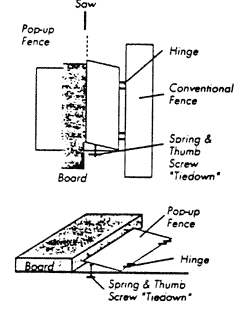
Figure 2 – Detail of pop-up fence
Figure 2A – Detailed "elevation" of the pop-up fence in the up position pop-up is about 1/8" over table surface.
The advantage of the pop-up fence over a conventional fence is that the edge of the pop-up is fixed, and lined up with the sawblade. The tendency which is common with use of the conventional fence to cut a little wider edging strip than necessary is eliminated.
When a "solid" or "dimension" part has to be cut some preset width and the conventional fence and ripsaw stop has to be employed, the board is simply put on top of the pop-up fence, its weight pushes the pop-up flat and even with the surface of the ripsaw table (Fig. 3). The conventional fence and stop then is used to cut the required width of stock.
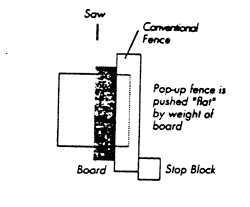
Figure 3 – Cutting a specified width piece
Tip 26
Flip stops also reduce edging losses.
The pop-up fence mentioned above helps to reduce losses when a board is first edged (usually the first ripsaw cut on a board). Flip stops help to reduce the size of the final edging strip on a board (usually the last ripsaw cut on a board).
When a board is ripped, often it is desirable for the operator to cut a random width strip of wood for gluing rather than cut a last dimension piece (specified width ripping) from the board. This situation occurs when the cutting of the dimension piece would result in a strip of wood being "leftover" which is too small to use (Fig. 4).

Figure 4 – Cutting which produces a leftover strip which is too small to use and how to avoid this loss.
However, there is a problem in cutting the random width strip because it will be wider than the dimension piece. The preset stop will prevent the fence from moving far enough to allow the wider, random width strip to be cut (Fig. 5). It would be possible to cut the wider strip by turning over the board, but this is not recommended if "square" glue joints need to be produced, particularly if the lumber is not surfaced evenly on both sides of the board (skip dressed).
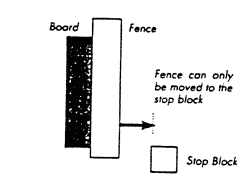
Figure 5 – Stop block prevents cutting of a random width piece wider than the dimension piece.
The solution is to attach (weld or bolt) a "flip stop device" onto the conventional stop block (Figs. 6 and 7). Once this is done, when the operator sees that cutting another dimension piece would result in the production of a "leftover" strip, the flip stop device can be raised with a "flick" of the operators hand, thus allowing the fence to move back further and the wider, random width piece for gluing to be cut.

Figure 6 – Use of a flip stop on a straight line ripsaw
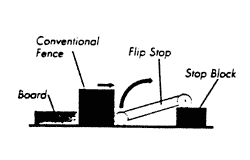
Figure 7 – Elevation of a flip stop: flip stop can be raised allowing the conventional fence to move far enough to cut a wide strip for gluing.
There is at least one commercial, multiple-position stop which is available for purchase. The device is a rotating drum, from which "bolts" of varying lengths extend which function as stops (Fig. 8). The bolt-stop of the appropriate length can be selected by the operator rotating the drum into the appropriate position as he cuts the board. Another advantage of this device is that more than one specified width can be cut from the board without resetting the stops. This also can contribute to yield and productivity improvements.
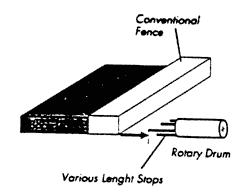
Figure 8 – Rotary drum stop system for a straight line ripsaw.
Tip 27
A simple "Ink Pen" device can aid in laying-up panels for gluing.
There are now available computerized and mechanical devices which assist companies to accurately lay-up panels for gluing, and avoid the previously common, wasteful practice of oversizing panels. There are also simple devices, which although not as effective as the more sophisticated systems, offer an alternative for the budget-tight manufacturer.
The ripsaw tail person lays up the panel to width on a factory truck or conveyor. When it is required to cut the last piece in the panel to make the panel the desired width, the tail person slides a board under the "Ink Pen" (magic marker type) device which marks on the board where it should be cut. The tail person then passes the board to the ripsaw operator for cutting.
For more infomation, including videos, books, and training programs, visit the: The International Productivity Center Web site at http://www.woodvideo.com/. Their products are designed to assist manufacturers of lumber, furniture, cabinets and similar wood products in their machine operator and supervisory training efforts.